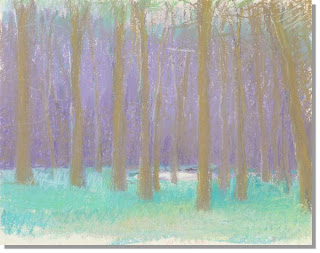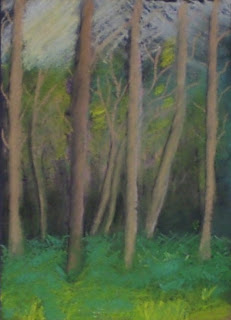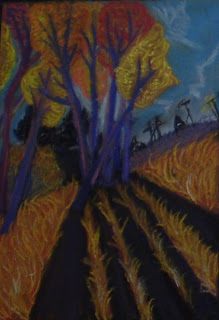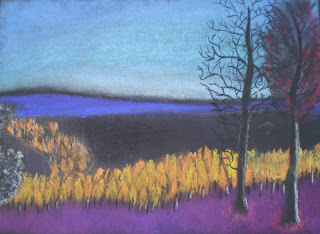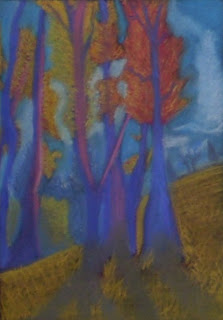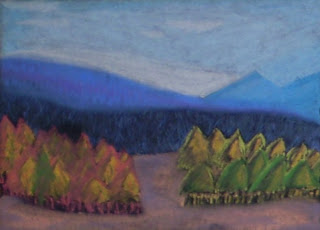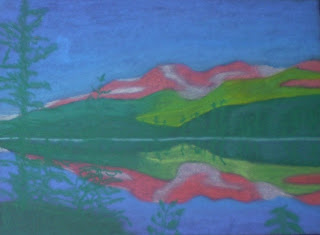
The Art Problem:
This Creative Challenge invites students to interpret the idiom of their choice through the creation of clay sculptural busts (about 2/3 lifesize). In the example provided, my student Rachel A. chose the idiom "A Little Birdie Told Me" because of its relationship to high school gossip. Once fired, students enhance both the form and content of their pieces with a cold finish by, first, underpainting them in black, then dry brushing white or off-white over the black and, finally, adding highlights, shadows, mood and surface texture through mark-making in colored pencils.
Materials:
Clay compatible with your kiln and cones
Ware boards
Basic clay tools for cutting, incising, smoothing, scoring, piercing, embossing
Plastic for covering pieces while drying
Kiln, kiln furniture and conesBlack acrylic paint for under painting (we used spray paint) outdoors
White or off-white acrylic paint (dry brushed on)
Medium to medium-large brushes (foam works fine)
Colored pencils
Clear acrylic spray (we sprayed them outdoors)
Procedures:
Note: My students selected their idioms just prior to their midterm exam and drew thumbnails as part of their exam, though they were free to change their minds afterward.
Day 1--Introduction:
1. Show sample portrait bust and define idiom.
2. Hold an idiom-generating competition: challenge small teams of students to generate as many idioms they can in a specified amount of time. Have winning team read their list; other teams can add any additional ones from their lists. Give prizes to the team with the most.
3. Play Idiom Pictionary on the board. Give prizes to the team who gets the most correct answers.4. Introduce students to basic clay vocabulary and processes: wedge, score, slip, model, pinch, coil, slab, emboss, pierce, additive, subtractive, surface design. Per table or team of about 4 students, have two sets of different colored cards ready: vocabulary words on one set and definitions on another. Ask students to correctly match. Repeat on the next day of class as a hook/review.
Days 2 and 3--Facial Feature Practice:
5. Demonstrate modeling of facial features and let students practice with a small ball of clay. This is an excellent time to also instruct them in the way they should set-up and clean-up their work space.
Days 4-9 or 10--Construction:
6. Show YouTube demonstration video by Phillipe Faraut. In our case, Faraut makes the nose and lips a little differently than I learned from Hildreth and taught my students, so this gives the kids an option. Describe and diagram the building of shoulders and neck (a demo isn't really necessary once they see a sample and diagrams on the board).
7. Add head and begin making facial features. Have sample diagrams of facial anatomy from both front and profile views on view. Emphasize that the "egg-shaped" head must be placed on the neck at an angle AND that the front of the "egg" must be flattened slightly, making it perpendicular to the table, so that the face will be looking forward, rather than up (unless students want their heads looking up.) Also advise them that a slight tilt or turn of the head when they attach it to the neck can create a more lifelike quality.
8. Hollow out head and then torso and neck using a loop tool, preferably, though a spoon will work. To hollow out heads, use a clay cutter to remove the top of the cranium, and hollow down through the head to the neck, leaving a 3/4-1" wall. Replace the top of the head using scoring and some water or slip, if necessary. (It helps to make register marks so that the part of the head that is cut off can be positioned properly when it is reattached.) This will lighten the head so that the neck and torso can support it. Hollow them out next. Reshape any facial features if necessary.
9. Add any other elements, including hair and clothing, necessary to effectively interpret the idiom. Note: I tend to prefer these portrait busts without hair, though Faraut demonstrates an effective way to create hair that doesn't look like a rag mop.
4 Weeks (approximately)--Drying, Preheat and Firing:
10. Dry sculptures with plastic very loosely covering them. Have students check any thin elements. Spritz with water and cover those areas more tightly if necessary. It took ours about three weeks, not counting the preheat, to dry. To speed drying, tape three popsicle sticks together and carefully place two sets under the torso, one at each end. This will allow air to circulate underneath.
11. Preheat--as an extra precaution, I load the kilns and preheat them on low for about 45 minutes every day for about 4 days. After each preheat, I turn them off and just let them sit over night until the next day when I repeat the procedure.
12. Firing--on the 5th day, I fire them slowly and let them cool over the weekend.
1 Week--Cold Finish:
13. Students work outside in teams of 4 students, to spray paint their busts matte black; place newspaper under sculpture. Once dry--and the paint dries quickly--students bring them inside and dry brush the surfaces with white or off-white acrylic paint, leaving some black showing, especially in the crevices.
14. For the next couple of classes, students use colored pencils to build up a patinaed surface, with generally cool colors in the shadows and warm colors in the highlighted areas, that is, where light naturally strikes the sculpture. Encourage students to limit their dominant color palette and to build up their surfaces slowly while layering tones and letting some of their marks show.
15. Finish the sculptures outside with a couple of coats of a sprayed on clear acrylic finish.
Big Ideas:
Artworks are objects for interpretation.
Art is a reflection of time, place and culture.
Meaningful artmaking is about exploration, asking questions, problem-solving and developing a knowledge-base.
Idioms are figurative language related to time, place and culture.







